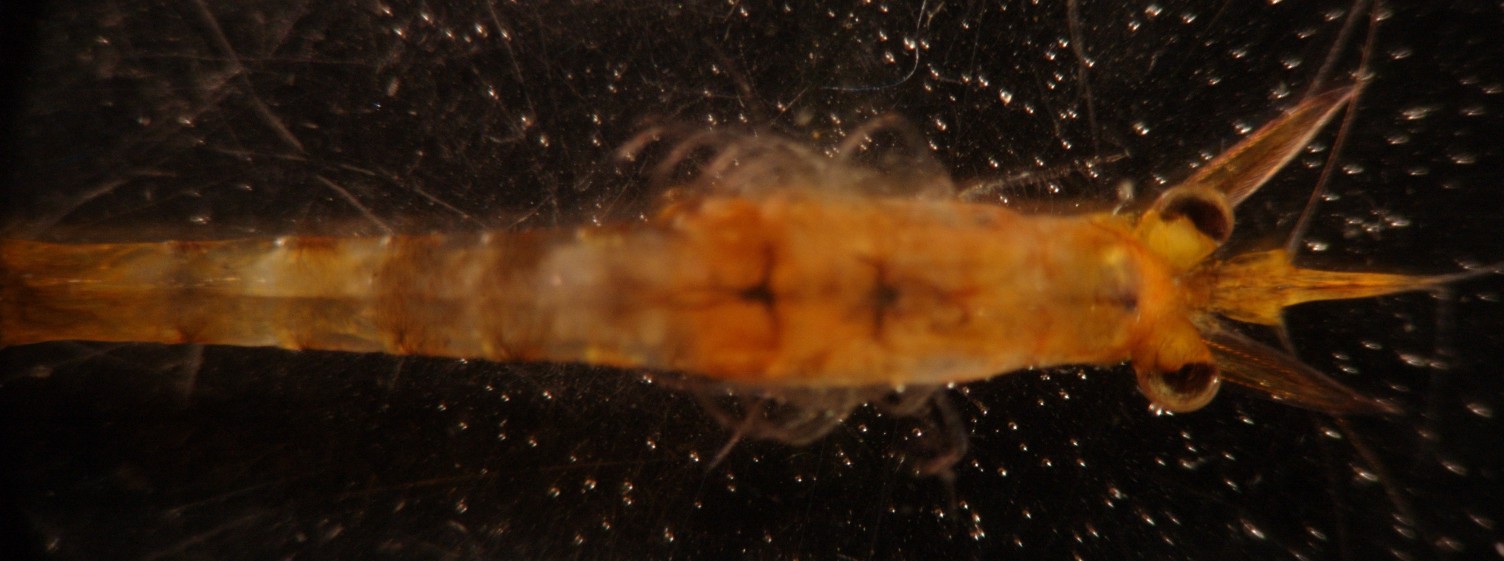Description: This mysid does not have numerous long spines on its carapace and abdomen. The cornea of the eye is not divided into two portions (photo). The scale of antenna 2 has a rounded tip and both the inner and outer margins have setae (photo). The carapace is not expanded laterally and anterolateral margin of the carapace is rounded (photo). The last abdominal segment is smooth, with no transverse folds. It has a nearly straight posterior dorsal margin, without an acute mid-dorsal projection (photo). The telson is not cleft (photo). It has two large spines on the end and a row of many spines of equal size along each margin (photo).
How to Distinguish from Similar Species: Several other mysid species have acute anterolateral margins on the carapace. Pacificanthomysis nephrophthalma has a telson with alternating sets of shorter spines among the longer spines along the lateral margins.
Geographical Range: At least in the Bering Sea, Sea of Okhotsk, and Arctic Ocean. K. Derjugen (1912) lists this species in an article about Arctic Ocean species in the collection from the Murmansk Marine Laboratory near St Petersburg, Russia. A UN project document for NW India (Gujarat?) lists this species as occurring in that portion of the northern Indian Ocean.
Depth Range:
Habitat: I found clusters of this mysid hovering around kelp in a low intertidal tidepool (photo).
Biology/Natural
History:
This species
is probably pelagic
or benthopelagic.
It swims vigorously with its pereopods
(thoracic appendages). Inner branches of these same pereopods
make up the oostegites
(flaplike covers which fit together into a marsupium
(pouch) to shelter the eggs and larvae on the female's abdomen).
Wing (1975) reports in Fishery Bulletin 73: 169-185 that the
ellobiopsid
parasite Thalassomyces
albatrossi
(a protist) parasitizes a close relative of this species.
Ellobiopsids
typically appear as a stringy white mass attached to the ventral side
of
the anterior abdominal segments. The Great Soviet
Encyclopedia states
that mysids such as this can be found from the surface to a depth of 7
km and also in brackish waters, lakes, and rivers and that they serve
as
food for herring, sprat, perch, cod, and other fish. The
accompanying
photo with the article in the Great Soviet Encyclopedia, however, is of
an amphipod
rather
than a mysid. This species is one of the food items for young
ribbon
seals. They can be found near the sea ice over the
continental shelves
in spring feeding on algae under the ice.
| Return to: | |||
| Main Page | Alphabetic Index | Systematic Index | Glossary |
References:
Dichotomous Keys:Kozloff, 1987, 1996
General References:
Scientific Articles:
Boveng, P.L., J.L. Bengston, T.W. Budkley, M.F. Cameron, S.P. Dahle,
B.A. Megrey, J.E. Overland, and N.J. Williamson, 2008. Status
review
of the ribbon seal (Histriophoca
fasciata).
NOAA Technical Memorandum NMFS-AFSC-191.
Derjugen, K., 1912. Die Murmansche biologische station der K. naturforscher Gesellschaft zu St. Petersburg und ihre arbeiten im Nordischen Eismeer. Proceedings of the Seventh International Zoological Congress, Boston, 19-24 August, 1907
Kathman, R. D., W. C. Austin, J. C. Saltman, and J. D. Fulton. 1986. Identification manual to the Mysidacea and Euphausiacea of the northeast Pacific. Department of Fisheries and Oceans,Ottawa, Canada. 411 p.
Web sites:
General Notes and Observations: Locations, abundances, unusual behaviors:
Here is the swarm of mysids in the tidepool the above individual was sampled from. Photo by Dave Cowles, July 2012
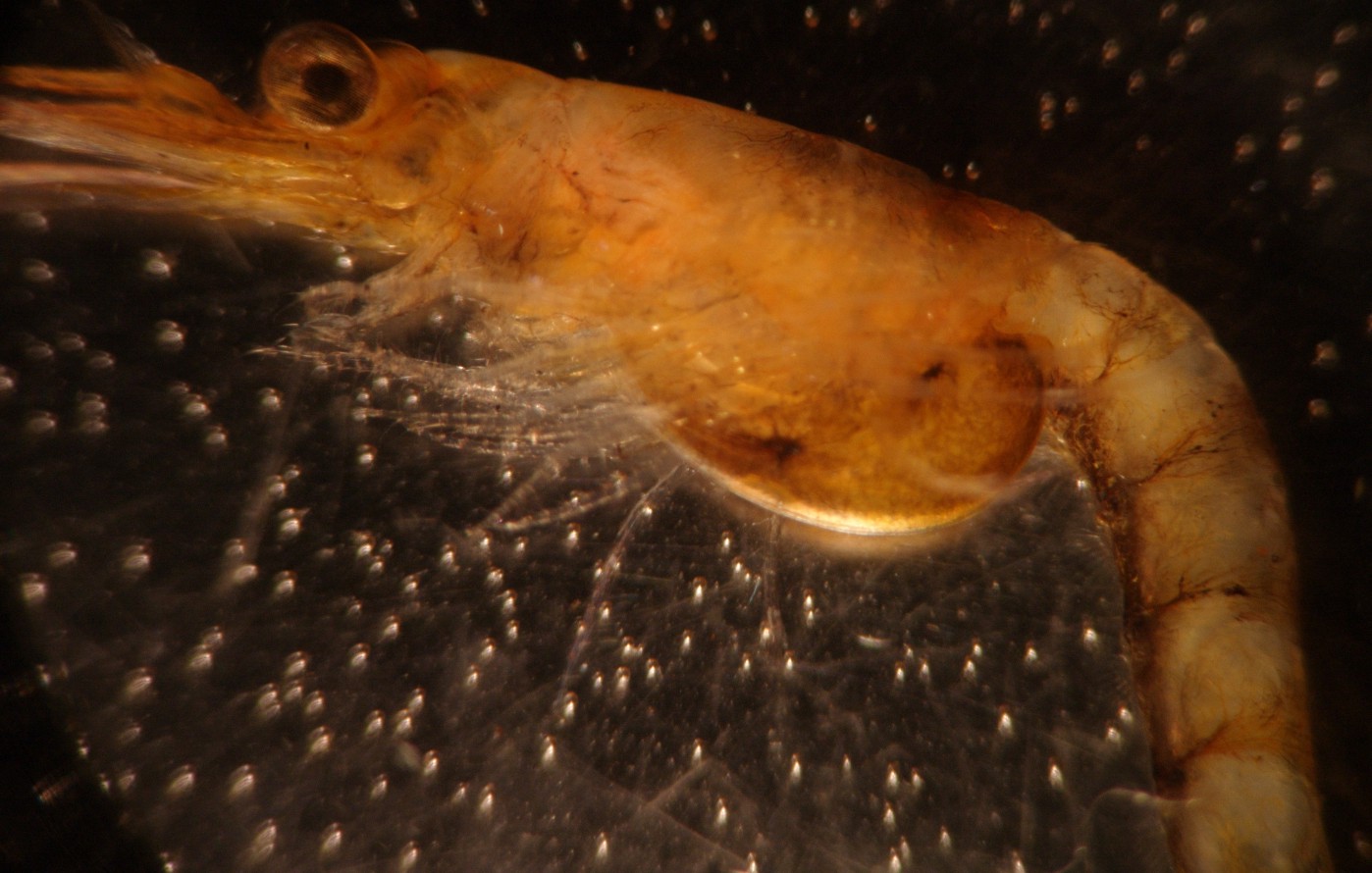
This side view shows the large pouch (marsupium)
the females use to carry their eggs and larvae. The marsupium
is made up of flattened, leaflike inner projections of the legs called
oostegites.
Only the females have oostegites.
The anterolateral corner of the carapace
is rounded instead of having a sharp projection.
Characterisitics used for identifying this species:
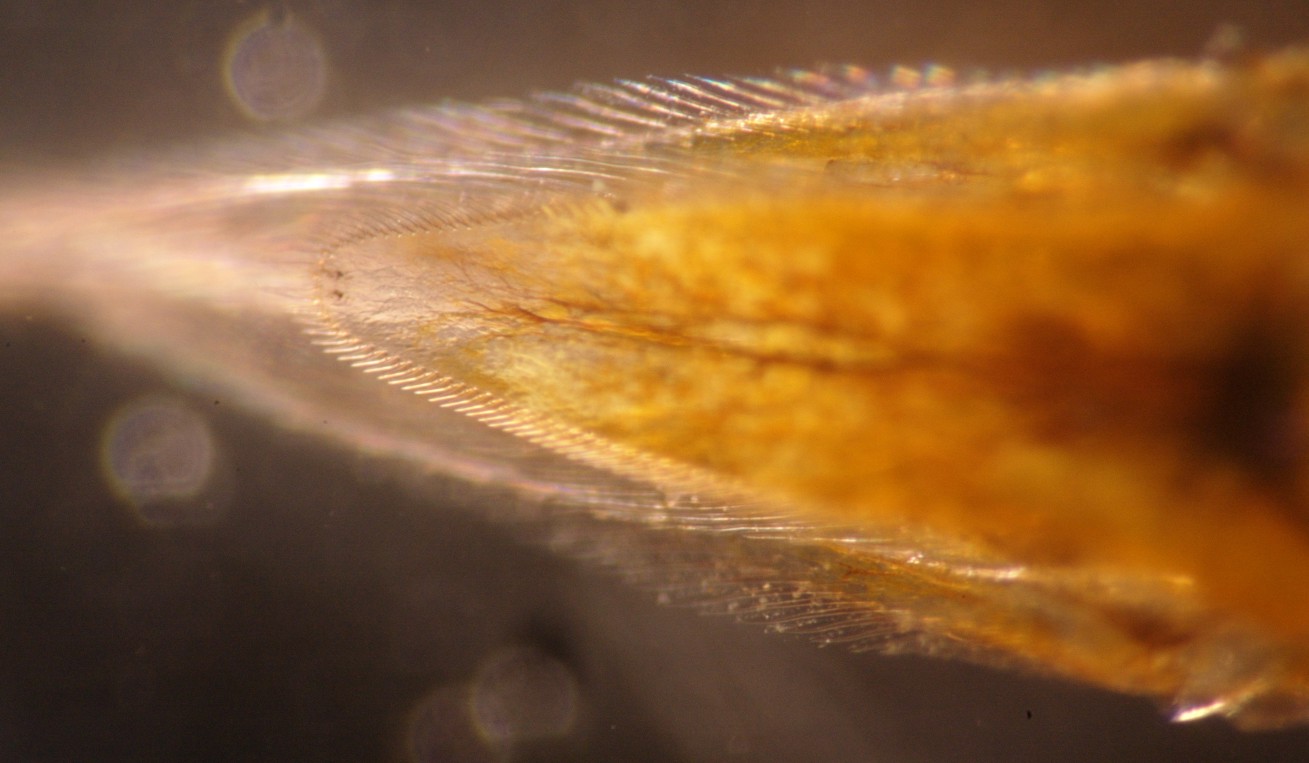
The telson
is not cleft. It has a row of equal-length setae
along the lateral margins and two longer setae
at the tip. Dorsal
view.
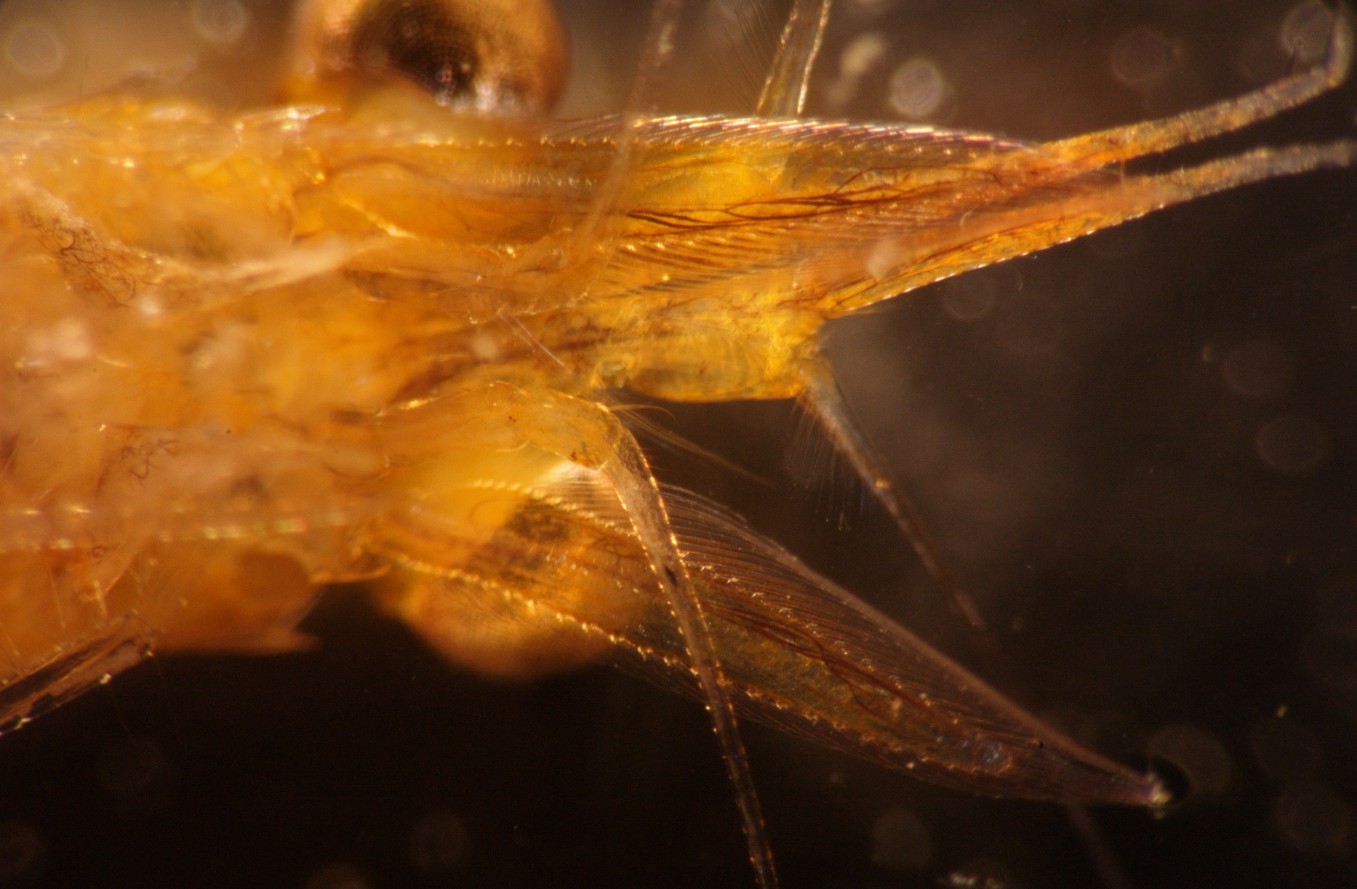
The eye is not divided into two portions. The antennal
scale of antenna 2 is rounded on the end and has setae
along both lateral margins.
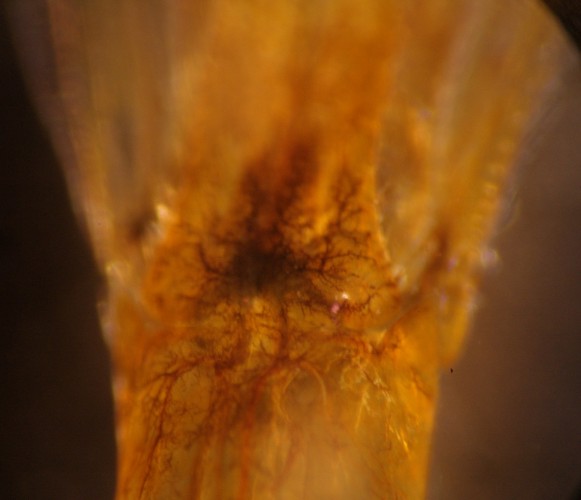
The posterior end of the last abdominal
segment is nearly straight, without a dorsal
projection toward the telson.
None of the abdominal
segments have dorsal
transverse
folds.
Other interesting views:
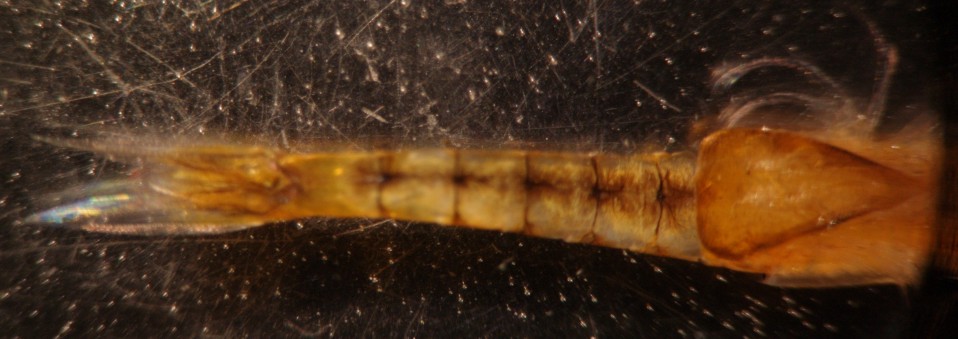
This view of the underside of the abdomen
shows that the pleopods (abdominal
appendages) are very small and feathery. The underside of the
marsupium
can also be seen, as well as several powerful pereopods
with which the animal swims.
Authors and Editors of Page:
Dave Cowles (2012): Created original page
CSS coding for page developed by Jonathan Cowles (2007)
Salish Sea Invertebrates web site provided courtesy of Walla Walla University
